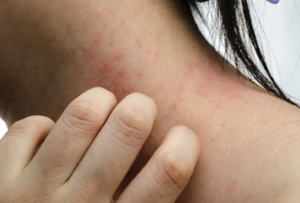Most allergies cause an immediate reaction. These include allergies to pollen, dust, animals, foods, and insects. However, metal allergy and other contact allergies are different. They cause a delayed hypersensitivity reaction that can take days or even weeks to react. Unlike immediate hypersensitivity reactions, they don’t get better with antihistamines. They are mediated by a different part of the immune system called Cell-Mediated Immunity.
Metal allergies are common contact allergies. Contact allergies affect at least 20% of the population and metal allergies, in particular, affect 10% to 15% of the population. When there is already a history of contact allergies, the incidence of multiple contact allergies goes up.
Metal Allergy Symptoms
Most of the time, contact allergies cause a rash. When implanted into the body, however, patients can have even more severe symptoms including:
- Swelling
- Pain
- Draining sinuses
- Inflammation at the implant site that mimics infection

Common allergens that cause contact allergies include poison ivy, ingredients in creams, lotions, shampoos, and even certain hair dyes. Metals, rubber products, and even certain topical medications can cause contact allergies.
The most common contact allergies to metals include nickel, cobalt, copper, and chromium.
Common sources of reactions to metals include jewelry and piercings, backs of watches, belt buckles and other clothing items, glasses and even cooking utensils.
Medical devices that potentially have metals include, but are not limited to surgical orthopedic devices, cardiac stents and pacemakers, and dental products such as fillings, dental implants. Other sources include certain tattoo inks, foods, supplements, and cosmetics.
Metal Allergy Testing and Treatment For Medical Devices
Testing for contact allergens is done through an allergy patch test. There is no blood test for contact allergens. When we do a metal patch test, we apply patches containing the individual allergens on a patient’s back and leave them on for 48 hours. We remove the patches and observe if there have been any reactions to the items being tested. The back is then examined in the office 24 hours later to see if there has been a 72-hour reaction. The patient will then report on their own if anything flared up over the next week. If any of the metals being tested elicit a reaction, contact your surgeon and then look for an alternative.
The best option for the treatment of metal allergies is to remove the metals in question and treat the rash with topical or systemic steroids. For implanted devices, this may be difficult, so many surgeons now are doing patch testing before the procedures to decrease the risk of their patients having contact allergens.
At NY Allergy and Sinus Centers, we do complete patch testing on 10 different metals. If you need allergy testing before a planned procedure involving a metal device, book an appointment and please let our patient representative know you are getting a metal patch test, so your custom patch can be prepared prior to your visit. Make sure your appointment is done with time allowed for your patch reading 2-3 days after the placement.
Metal Allergy Frequently Asked Questions
Can Zinc-containing Dental Fillings Cause An Allergic Reaction?
Yes, zinc-containing dental fillings can cause an allergic reaction. It's best to get allergy tested for metals before getting metal fillings or implants.
How Can You Prevent Metal Allergy?
Avoid metal allergy by wearing hypoallergenic jewelry. Look for jewelry made from such metals as nickel-free stainless steel, surgical-grade stainless steel, titanium, 18-karat yellow gold, or nickel-free yellow gold and sterling silver.
How Common Is Metal Allergy?
Metal allergy affects 10% to 15% of the population. Metal allergies are increasing in the United States and can develop at any age. They are more common in women and girls than men and boys.
How Do You Treat Metal Allergy?
The first step in treatment is avoidance. You should avoid any metal that triggers a reaction. An allergist can also treat your symptoms with antihistamine creams.
How Is Metal Allergy Diagnosed?
An allergist can usually diagnose nickel allergy based on your skin's appearance, and a recent exposure to items that may contain metal. However, if the cause of your rash isn't apparent, your doctor may recommend an allergy patch test.
What Are the Symptoms of A Metal Allergy?
Symptoms of metal allergy may include redness, itching, swelling or a rash, with skin blistering or scaling at the site. Symptoms may range from mild to severe.
What Is the Most Common Metal Allergy?
Nickel is the most common allergy. It is the most widely used metal alloys on the planet. Stainless Steel contains trace amounts of nickel and iron and therefore may cause a reaction to those with hypersensitive skin.
When Do Metal Allergy Symptoms Appear?
You’ll usually see symptoms 12 to 48 hours after you come into contact with metal. However, some symptoms may appear immediately.
Which Metals Cause An Allergic Reaction?
Nickel, cobalt, copper, and chromium are common culprits of metal allergy. They cause the most severe reactions.

